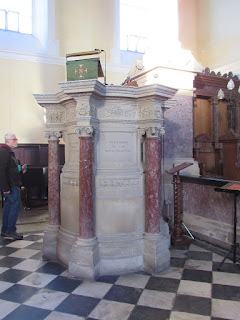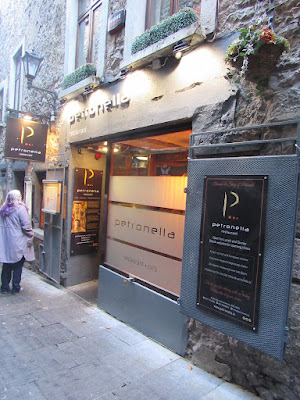When most people think of Waterford, they think of crystal--the finest crystal in the world. However, to learn about the story of the evolution of the company, is to learn a lesson about the global marketplace, which isn't always kind to local businesses.
The biggest market for Waterford Crystal was the USA--about 90 percent of its sales. Eventually, the factory was purchased by Americans. Then a London competitor called Wedgewood challenged Waterford's advantage. After that, the Chinese began making crystal only at a lower price. This move truly killed the economy in Waterford, however, because the company could not compete.
Then a local man bought the company and re-employed many of the workers who lost their jobs in the economic downturn. However, the company had difficulty recovering and regaining its previous prestige because some pieces were not made in Waterford. This factor reduces its collectibility.
The Waterford Crystal factory also houses a museum, and it provides tours of the ancient art of glass-blowing, cutting, sculpting, etching, and engraving by hand.
The factory produces 750 tons of quality crystal every year.
Across the street from the factory is the company's showroom and café. As the pieces below show, Crystal is not only about tableware. These pieces are beautiful--and expensive.

Vikings
Waterford's history goes further back than its crystal company. The Vikings founded the city in 914--older than all the North European capitals except Paris and London. And it is the only Irish city to retain its Viking place name--Vedrarfjordr--an Old Norse word meaning "haven from the windy sea" or "winter port". The Irish named the city Port Láirge, the port of the thigh.

The triangular settlement, known as the Viking Triangle, was bounded on two sides by water--the river Suir on the north and a tidal marsh that was used as a harbor. This location was easy to defend since it had access to coast and inland rivers for their raids. It was also an ideal spot for the Vikings to use as a base for settlement and international trade.
The 13th century stone wall opposite follows the line of the earlier Viking defenses. In the 18th century this area was drained and a formal tree-lined Mall was established.
 The Vikings were tough and skilled seamen. They traveled around Europe and across the Atlantic Ocean in boats like this one, which were amazingly small considering the places they went. This one is 39 feet long and built by a local shipwright.
The Vikings were tough and skilled seamen. They traveled around Europe and across the Atlantic Ocean in boats like this one, which were amazingly small considering the places they went. This one is 39 feet long and built by a local shipwright.
Reginald's Tower was built by the Anglo-Normans after their conquest of Waterford. The tower replaced the one the Vikings had built. The present tower is likely to have been built between 1253 and 1280. It has been used as a mint, a prison, and a military storehouse. It is also famous for being the location of the wedding of Richard de Clare, the second Earl of Pembroke, and Aoife (pronounced eefa), daughter of Dermot MacMurrough, King of Leinster. It occasionally served as a royal castle for King John in 1210 and Richard II in 1394 and 1399. He used the tower to store his munitions. It is now used as a museum with Viking artifacts dating back to 914.
This rendition of the Viking Sword is a beautifully
carved piece by John Hayes. It measures 75.5 feet in length and was created from a
single tree trunk with the roots still attached. It tells the story of the Vikings conquest and settlement of this area.


Christ Church Cathedral
In 1773, the old church was demolished and this cathedral was completed in 1779. It has a pillared altar with Hebrew letters on it. It was designed by Georgian architect John Roberts (1714-96).
A church dating from the time of the conversion of the Viking settlers was on this site prior to the foundation of the first cathedral in 1096. In that year the Archbishop of Canterbury consecrated Malchus, an Irish monk who trained with him to be the first Bishop of Waterford. The consecration took place at the request of the O'Brien kings of Munster, overlords of the Viking city of Waterford.
Malchus, a reformer, later became Archbishop of Cashel and worked to bring the Irish Church into line with practice on the continent. Institutional changes were accompanied by a new style of architecture known as Romanesque.



The tomb of James Rice is a cadaver tomb, one of the finest in Ireland. This limestone mensa or table tomb features a partially decomposed cadaver motif on top dating from c. 1482. The niches below the cadaver is decorated with gothic style niches and images of saints and apostles. The idea of this particular tomb was to remind those who gaze upon it that they will some day be in a similar state in time.
John Robert's home is simple and apparently well-suited for his family. He lived there for most of his adult life with his wife and their 24 children. Eight of them lived to adulthood.
Roberts was born in Waterford in 1712 or 1714, the son of Thomas Roberts, an architect and builder. At 17, he eloped with Mary Susannah Sautelle, a Huguenot heiress who also lived in Waterford.
He had the distinction of designing both the Catholic and Protestant cathedrals in Waterford: Christ Church (1770s) and Cathedral of the Most Holy Trinity (1790s).
Some street scenes that give Waterford some character. Our hotel faced the river, which made it especially intriguing to be in this old town of the Vikings and imagine their lives here.


Resources
Reginald's Tower -- https://en.wikipedia.org/wiki/Reginald%27s_Tower
Jack Burtchaell's Walking Tour of Waterford -- https://visitwaterford.com/vw_listing/jack-burtchaells-walking-tour/
The Viking Triangle -- https://www.theirishroadtrip.com/viking-triangle-waterford/
























































